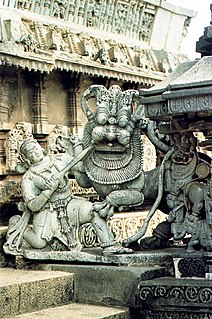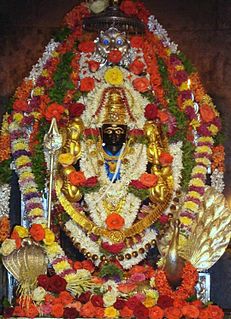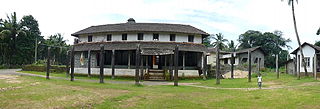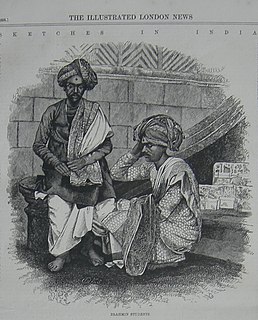
Tulunad or Tulu Nadu, also called Bermere sristi or Parashurama Srishti, is a region and a proposed state on the southwestern coast of India. The Tulu people, known as 'Tuluva', speakers of Tulu, a Dravidian language, are the preponderant ethnic group of this region. South Canara, an erstwhile district and a historical area, encompassing the undivided territory of the contemporary Dakshina Kannada and Udupi districts of Karnataka State and Kasaragod district of Kerala state forms the cultural area of the Tuluver.

South Canara was a district of the Madras Presidency of British India, located at 13.00°N 75.40°E. It comprised the towns of Kassergode and Udipi and adjacent villages, with the capital in Mangalore city. South Canara was one of the most heterogeneous areas of Madras Presidency, with Tulu, Malayalam, Kannada, Konkani, Marathi, Urdu& Beary languages being spoken side by side. It was succeeded by the Tulu-speaking areas of Dakshina Kannada district, the Malayalam-speaking area of Kasaragod district and the Amindivi islands sub-division of the Laccadives, in the year 1956.
Kalady or Kaladi is a town located between Angamaly and Perumbavoor, east of the Periyar river, near to Malayattoor in Ernakulam district of Kerala, India, not far from Cochin International Airport. It is notable as the birthplace of 9th century Indian philosopher Adi Shankara.
The Saraswat Brahmins are Hindu Brahmins, who are spread over widely separated regions spanning from Kashmir in North India to Konkan in West India to Kanara and Kerala in South India. The word Saraswat is derived from the Rigvedic Sarasvati River. Most of Sarswat Brahmins are on Rajasthan north side, Haryana south side and most places on Punjab.
Kota Brahmins are a Hindu Brahmin subcaste mainly from the Indian state of Karnataka. Kota Brahmins take their name from their native village Kota. They speak a Kannada different from the other regional dialects. Kota Brahmins are mainly concentrated in the villages of Kota of Udupi district. Kotas follow Smarta tradition. The Guru Narasimha Temple, Saligrama is important to them.

Tigalari, also known as Tulu script, is a Southern Brahmic script which was used to write Tulu, Kannada, and Sanskrit languages. It was primarily used for writing Vedic texts in Sanskrit. It evolved from the Grantha script. It is called as Tigalari lipi in Kannada-speaking regions and Tulu speakers call it as Tulu lipi. It bears high similarity and relationship to its sister script Malayalam, which also evolved from the Grantha script.
Karnataka Brahmins or Carnatic Brahmins are Pancha Dravida Brahmin communities native to the Indian state of Karnataka.They are classified into two sub-divisions based on their places of origin in Karnataka, "Kannada Nadu" or "Karu Nadu" and "Tulu Nadu". The Karnataka Brahmins from Kannada Nadu region are known as Kannada Brahmins, while the Karnataka Brahmins from Tulu Nadu region of Karnataka are known as Tuluva Brahmins

Hoysala Karnataka Brahmins are a community of Kannada-speaking Smartha Brahmins. This sect of Brahmins are spread over the Southern Districts of the Indian state of Karnataka, most of the concentration being mainly in the districts of Chikmagalur, Hassan, Shimoga, Mysore and Bangalore.

Gaud Saraswat Brahmins (GSB) are a Hindu Brahmin community of the north. The Konkani speaking Gaud Saraswat of Goa and southern India claim to be descendents of these Gaud Saraswat Brahmins of the north that migrated to Konkan from Gaud, as per the Skanda Purana. Their traditional occupation was trading.
Halenadu Karnataka Brahmins (HKBs) are a sect of Kannada speaking Smartha Brahmins and follow Advaita Vedanta propounded by Adi Shankaracharya. HKBs are essentially Rig Vedic Brahmins and are known to follow Dharmaśāstra extensively in their life.
Shenoy is a surname from coastal Karnataka and Goa in India. It is found among Hindus of the Goud Saraswat Brahmin community following Smartha Sampradaya of Kavale Matha or Madhva Sampradaya of either Gokarna Matha or Kashi Matha.

Sthānika Brāhmins belong to Hindu Tuluva Smartha Brahmin group.

Tulu Nadu State movement is aimed at increasing Tulu Nadu's influence and political power through the formation of separate Tulu Nadu state from Karnataka and Kerala. Tulu Nadu is a region on the south-western coast of India. It consists of Dakshina Kannada and Udupi districts of Karnataka, and Kasargod district up to the Chandragiri river in Kerala. The Chandragiri river is traditionally considered to be a boundary between Tulu Nadu and Kerala from the fourteenth century AD onwards. The first call for separate Tulu Nadu state was made just after the Quit India Movement in 1942 by Srinivas Updhyaya Paniyadi, a banker and a press owner from Udupi. Mangalore is the largest and the chief city of Tulu Nadu. Tulu activists have been demanding a separate Tulu Nadu state since the late 2000s, considering language and culture as the basis for their demand.

Balakudru Shrimatha is the Gurupeetha for the brahmins of South Canara District mainly Shivalli sects who follow Advaitha philosophy. This Peetha is now running upon the directions of Jagadguru of Shringeri Shaaradha Peetha. The ashram is headed now by Shri Shri Narasimhashrama Swamiji.

Canarese Konkani are a set of dialects spoken by minority Konkani people of the Canara sub-region of Karnataka, and also in Kassergode of Kerala that was part of South Canara. Kanarese script is the primary mode of writing used in Carnatacan Konkani, as recognised by the Konkani Academy.
Tulu Gowda and Arebhashe Gowda (Gauda) are primarily found in South Canara District, Kodagu District, Indian state of Karnataka and Bandadka village of Kasaragod. They are a subsect of the Vokkaliga community but are culturally and linguistically different. They speak Tulu and Arebhashe.

The Panchagrama Brahmins are a Brahmin community that follow the Smartha Sampradaya. They belong to the Indian state of Karnataka, and reside primarily in the districts of Udupi, Shimoga and Chikmaglur, Bengaluru and other cities.

Madhva Brahmins, are Hindu Brahmin communities in India, who follow Sadh Vaishnavism and Dvaita philosophy propounded by Madhvacharya. They are found mostly in the Indian states of Karnataka, Maharashtra, Goa, Tamil Nadu, Kerala, Telangana and Andhra Pradesh.
Kannada Brahmins are Kannada-speaking Brahmins, primarily living in Karnataka, although a few of them have settled in other states like, Telangana, Andhra Pradesh, Kerala and Tamil Nadu. They belong to one of the three main sects: Smartism, Sadh Vaishnavism, and Sri Vaishnavism and are followers of Shankaracharya, Madhwacharya and Ramanujacharya respectively. Madhva Brahmins are also called Sadh Vaishnavas and Madhwas. Sri Vaishnava Brahmins are also called Iyengars and Ramanujas.









